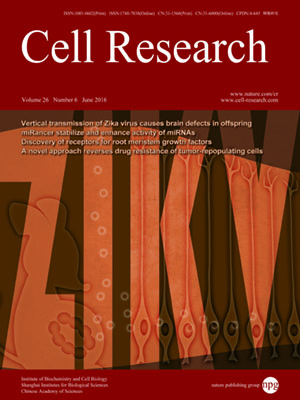
Volume 26, No 6, Jun 2016
ISSN: 1001-0602
EISSN: 1748-7838 2018
impact factor 17.848*
(Clarivate Analytics, 2019)
Volume 26 Issue 6, June 2016: 728-742
ORIGINAL ARTICLES
Loss of MeCP2 in cholinergic neurons causes part of RTT-like phenotypes via α7 receptor in hippocampus
Ying Zhang1,*, Shu-Xia Cao1,*, Peng Sun1, Hai-Yang He1, Ci-Hang Yang1, Xiao-Juan Chen1, Chen-Jie Shen1, Xiao-Dong Wang1, Zhong Chen1, Darwin K Berg2, Shumin Duan1,3 and Xiao-Ming Li1,3
1Department of Neurobiology, Institute of Neuroscience, Key Laboratory of Medical Neurobiology of the Ministry of Health of China, Collaborative Innovation Center for Brain Science, Zhejiang University School of Medicine, Hangzhou, Zhejiang 310058, China
2Neurobiology Section, Division of Biological Sciences and Center for Neural Circuits and Behavior, University of California, San Diego, La Jolla, CA 92093-0357, USA
3Soft Matter Research Center, Zhejiang University, Hangzhou, Zhejiang, China
Correspondence: Xiao-Ming Li, Tel/Fax: +86-571-8820-8757(lixm@zju.edu.cn)
Mutations in the X-linked MECP2 gene cause Rett syndrome (RTT), an autism spectrum disorder characterized by impaired social interactions, motor abnormalities, cognitive defects and a high risk of epilepsy. Here, we showed that conditional deletion of Mecp2 in cholinergic neurons caused part of RTT-like phenotypes, which could be rescued by re-expressing Mecp2 in the basal forebrain (BF) cholinergic neurons rather than in the caudate putamen of conditional knockout (Chat-Mecp2−/y) mice. We found that choline acetyltransferase expression was decreased in the BF and that α7 nicotine acetylcholine receptor signaling was strongly impaired in the hippocampus of Chat-Mecp2−/y mice, which is sufficient to produce neuronal hyperexcitation and increase seizure susceptibility. Application of PNU282987 or nicotine in the hippocampus rescued these phenotypes in Chat-Mecp2−/y mice. Taken together, our findings suggest that MeCP2 is critical for normal function of cholinergic neurons and dysfunction of cholinergic neurons can contribute to numerous neuropsychiatric phenotypes.
10.1038/cr.2016.48
FULL TEXT | PDF
Browse 1884


